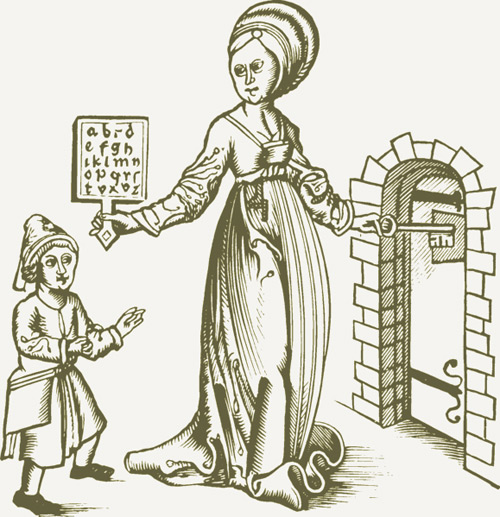This battered bit of wood was once a ubiquitous piece of schoolroom equipment. Can you guess what it was used for? On first look, taking the terrible beating it seems to have suffered into account, it’s tempting to guess “A paddle for spanking the little brat’s backsides!”(yes, the good ol days ay?) Though I have zero doubt that this item did speed through the air only to come to rest on naughty backsides, repeatedly, punishment was not in fact its primary function. It was actually a simple primer used for teaching children their alphabet. It was called a “hornbook” and was used in classrooms for at least 400 years. The letters on the model above have long since disappeared, obviously, but take a look below for some more representative models and some accompanying history.


“A hornbook consists of a piece of parchment or paper lesson pasted onto a paddle-shaped piece of wood. The name derives from the leaf of horn, made from sheep and goat horn that was softened and then boiled in water to produce true horn that could be pressed and cut into sheets, that was attached to the board by a brass or latten border by minute tacks. Hornbooks generally presented the alphabet above arabic numerals and the Lord’s Prayer. This evidence of rudimentary letter-learning and the hardiness of the hornbook itself speaks to the very young audience the hornbook aimed to please and more importantly indicates a tradition of reading material for the very young that dates back to the Middle Ages.” -The Victorian Web.


“To protect it from grubby fingers the sheet was mounted on a frame and was protected by a thin sheet of transparent cow’s horn – hence the name. The frame was usually made from wood, often oak, but occasionally more costly materials, such as silver or even ivory, were used. Wooden hornbooks were often covered in leather. Although the text itself was not illustrated, a picture was often engraved or embossed on the back of the frame. For the sake of utility, hornbooks often had a handle with a hole in the end, allowing them to be hung from a child’s belt or girdle.” -Andrew W. Tuer History of the horn-book.


“Hornbooks were particularly personal and often formed part of a child’s wardrobe, being attached by a string or thong to a belt. The hornbook’s physical intimacy both mirrors and promotes the child’s internalization of the alphabet.” -Patricia Crain The Story of A.


“In its early manifestations, the pedagogical alphabet is headed not by the letter A but by the “Christ Cross.” From at least the fifteenth until well into the nineteenth century, the alphabet’s English nickname was the “Christ-Cross Row,” shortened to “criss-cross row” and “crossrow.” Because the alphabet is associated with Catholic iconography, as if the two sets of signs were really part of one semiological system, one of the struggles of the Reformation would be to wrest the alphabet away from the Church.” -Patricia Crain The Story of A.
“Originally the letters of the alphabet had been laid out in a cross but that later, when the letters were arranged in lines, a cross was placed at the beginning to remind the pupil that “The fear of the Lord is the beginning of wisdom.” -Brewer’s dictionary of phrase and fable.


“There are records of hornbooks being in use until the mid-nineteenth century but their heyday was over. By the end of the nineteenth century the hornbook had not only gone out of fashion but surviving examples were extremely rare, as most had either been destroyed or lost. The few that did survive were mainly in the hands of collectors. The word hornbook survived as a term for an elementary treatise on a subject.” -King’s College London, book of the month page for May 07.


“The humble hornbook was treated with the full measure of contempt lavished on a thing which has served its purpose. ‘Destroy and forget,’ said everybody, and alas! Everybody did. That a tool which was used by so many generations of children over hundreds of years could be forgotten so easily seems almost impossible, yet it was.” -Andrew W. Tuer History of the horn-book.


Forgotten? Yes, indeed it was. I’d never even heard the word “hornbook” until this morning. But as is said, “you learn something new everyday,” even without having your ass paddled by a wooden alphabet primer.
The images were all adapted, and the quotes were all taken, from the following sources:
Read and Be Wise, Library of Congress.
Abracadabra: Language, Memory, Representation.
History of the horn-book, King’s College London.
Wikimedia Commons.
The Victorian Web.
The Hornbook and It’s Use in America, by George A. Plimpton.
IUPUI, The Hornbook.
Hope you enjoyed.


